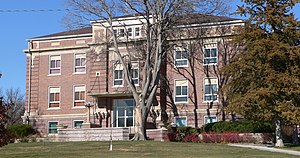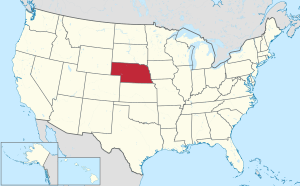Dundy County, Nebraska
Dundy County | |
|---|---|
 Dundy County Courthouse in Benkelman | |
 Location within the U.S. state of Nebraska | |
 Nebraska's location within the U.S. | |
| Coordinates: 40°11′N 101°41′W / 40.18°N 101.69°W | |
| Country | |
| State | |
| Founded | 1873 (authorized) 1884 (organized) |
| Named for | Elmer Scipio Dundy |
| Seat | Benkelman |
| Largest city | Benkelman |
| Area | |
| • Total | 921 sq mi (2,390 km2) |
| • Land | 920 sq mi (2,400 km2) |
| • Water | 1.2 sq mi (3 km2) 0.1% |
| Population (2020) | |
| • Total | 1,654 |
| • Density | 2.0/sq mi (0.8/km2) |
| Time zone | UTC−7 (Mountain) |
| • Summer (DST) | UTC−6 (MDT) |
| Congressional district | 3rd |
| Website | www |
Dundy County is a county in the U.S. state of Nebraska. As of the 2020 United States Census, the population was 1,654.[1] Its county seat is Benkelman.[2]
In the Nebraska license plate system, Dundy County is represented by the prefix 76 (it had the seventy-sixth-largest number of vehicles registered in the county when the license plate system was established in 1922).
History
[edit]Dundy County was formed in 1873 and attached to neighboring Hitchcock County.[3][4] It was named after Judge Elmer Scipio Dundy.[5][6] The county government was organized in 1884.[7]
Geography
[edit]Dundy County lies at the lower SW corner of Nebraska. Its west boundary line abuts the east line of the state of Colorado, and its south boundary line abuts the north boundary line of the state of Kansas. According to the US Census Bureau, the county has an area of 921 square miles (2,390 km2), of which 920 square miles (2,400 km2) is land and 1.2 square miles (3.1 km2) (0.1%) is water.[8]
Major highways
[edit]Adjacent counties
[edit]- Hitchcock County – east
- Rawlins County, Kansas – southeast
- Cheyenne County, Kansas – south
- Yuma County, Colorado – west
- Chase County – north
- Hayes County – northeast
Protected areas
[edit]- Rock Creek State Recreation Area[9]
Demographics
[edit]| Census | Pop. | Note | %± |
|---|---|---|---|
| 1880 | 37 | — | |
| 1890 | 4,012 | 10,743.2% | |
| 1900 | 2,434 | −39.3% | |
| 1910 | 4,098 | 68.4% | |
| 1920 | 4,869 | 18.8% | |
| 1930 | 5,610 | 15.2% | |
| 1940 | 5,122 | −8.7% | |
| 1950 | 4,354 | −15.0% | |
| 1960 | 3,570 | −18.0% | |
| 1970 | 2,926 | −18.0% | |
| 1980 | 2,861 | −2.2% | |
| 1990 | 2,582 | −9.8% | |
| 2000 | 2,292 | −11.2% | |
| 2010 | 2,008 | −12.4% | |
| 2020 | 1,654 | −17.6% | |
| 2021 (est.) | 1,635 | [10] | −1.1% |
| US Decennial Census[11] 1790–1960[12] 1900–1990[13] 1990–2000[14] 2010–2013[1] | |||
As of the 2000 United States Census,[15] there were 2,292 people, 961 households, and 637 families in the county. The population density was 2 people per square mile (0.77 people/km2). There were 1,196 housing units at an average density of 1 units per square mile (0.39/km2). The racial makeup of the county was 96.95% White, 0.04% Black or African American, 0.79% Native American, 0.48% Asian, 0.04% Pacific Islander, 0.87% from other races, and 0.83% from two or more races. 3.23% of the population were Hispanic or Latino of any race. 41.9% were of German, 13.2% American, 13.2% English and 6.3% Irish ancestry.
There were 961 households, out of which 27.80% had children under the age of 18 living with them, 59.90% were married couples living together, 3.90% had a female householder with no husband present, and 33.70% were non-families. 30.90% of all households were made up of individuals, and 17.60% had someone living alone who was 65 years of age or older. The average household size was 2.29 and the average family size was 2.87.
The county population contained 23.30% under the age of 18, 5.70% from 18 to 24, 23.50% from 25 to 44, 25.10% from 45 to 64, and 22.40% who were 65 years of age or older. The median age was 44 years. For every 100 females there were 96.90 males. For every 100 females age 18 and over, there were 93.40 males.
The median income for a household in the county was $27,010, and the median income for a family was $35,862. Males had a median income of $22,415 versus $18,583 for females. The per capita income for the county was $15,786. About 11.00% of families and 13.60% of the population were below the poverty line, including 16.10% of those under age 18 and 15.00% of those age 65 or over.
Communities
[edit]City
[edit]- Benkelman (county seat)
Village
[edit]Census-designated places
[edit]Other unincorporated communities
[edit]Former community
[edit]Politics
[edit]Dundy County voters are reliably Republican. In only three national elections since 1900 has the county selected the Democratic Party candidate (as of 2020).
| Year | Republican | Democratic | Third party(ies) | |||
|---|---|---|---|---|---|---|
| No. | % | No. | % | No. | % | |
| 2020 | 883 | 88.04% | 105 | 10.47% | 15 | 1.50% |
| 2016 | 823 | 86.36% | 89 | 9.34% | 41 | 4.30% |
| 2012 | 792 | 80.41% | 176 | 17.87% | 17 | 1.73% |
| 2008 | 783 | 76.84% | 218 | 21.39% | 18 | 1.77% |
| 2004 | 858 | 81.48% | 186 | 17.66% | 9 | 0.85% |
| 2000 | 801 | 79.23% | 179 | 17.71% | 31 | 3.07% |
| 1996 | 752 | 68.30% | 224 | 20.35% | 125 | 11.35% |
| 1992 | 664 | 52.99% | 245 | 19.55% | 344 | 27.45% |
| 1988 | 828 | 70.29% | 333 | 28.27% | 17 | 1.44% |
| 1984 | 992 | 80.98% | 225 | 18.37% | 8 | 0.65% |
| 1980 | 1,138 | 80.65% | 192 | 13.61% | 81 | 5.74% |
| 1976 | 774 | 61.28% | 457 | 36.18% | 32 | 2.53% |
| 1972 | 1,003 | 81.94% | 221 | 18.06% | 0 | 0.00% |
| 1968 | 1,001 | 72.01% | 261 | 18.78% | 128 | 9.21% |
| 1964 | 911 | 56.13% | 712 | 43.87% | 0 | 0.00% |
| 1960 | 1,245 | 71.92% | 486 | 28.08% | 0 | 0.00% |
| 1956 | 1,196 | 70.73% | 495 | 29.27% | 0 | 0.00% |
| 1952 | 1,670 | 80.79% | 397 | 19.21% | 0 | 0.00% |
| 1948 | 935 | 59.14% | 646 | 40.86% | 0 | 0.00% |
| 1944 | 1,320 | 68.29% | 613 | 31.71% | 0 | 0.00% |
| 1940 | 1,441 | 64.22% | 803 | 35.78% | 0 | 0.00% |
| 1936 | 1,054 | 43.77% | 1,328 | 55.15% | 26 | 1.08% |
| 1932 | 974 | 41.38% | 1,344 | 57.09% | 36 | 1.53% |
| 1928 | 1,575 | 76.42% | 472 | 22.90% | 14 | 0.68% |
| 1924 | 1,036 | 56.67% | 459 | 25.11% | 333 | 18.22% |
| 1920 | 1,094 | 69.59% | 375 | 23.85% | 103 | 6.55% |
| 1916 | 347 | 35.52% | 570 | 58.34% | 60 | 6.14% |
| 1912 | 148 | 16.82% | 304 | 34.55% | 428 | 48.64% |
| 1908 | 486 | 52.83% | 391 | 42.50% | 43 | 4.67% |
| 1904 | 395 | 65.61% | 92 | 15.28% | 115 | 19.10% |
| 1900 | 308 | 50.99% | 283 | 46.85% | 13 | 2.15% |
See also
[edit]References
[edit]- ^ a b "US Census Bureau". US Census Bureau. Archived from the original on May 1, 2022. Retrieved April 30, 2020.
- ^ "Find a County". National Association of Counties. Archived from the original on July 4, 2012. Retrieved June 7, 2011.
- ^ Fitzpatrick, Lilian Linder (1925). Nebraska Place-Names. Lincoln: University of Nebraska Studies in Language, Literature, and Criticism. p. 58. Retrieved December 14, 2014.
- ^ Andreas, A. T. (1882). "Andreas' History of the State of Nebraska". The Kansas Collection. Archived from the original on July 7, 2003. Retrieved December 14, 2014.
- ^ Gannett, Henry (1905). The Origin of Certain Place Names in the United States. Govt. Print. Off. p. 110.
- ^ Fitzpatrick, L.L.; Fairclough, G.T. (1960). Nebraska Place-Names. A bison book. University of Nebraska Press. p. 58. ISBN 978-0-8032-5060-4. Retrieved May 13, 2019.
Dundy county was named in honor of Judge Elmer S. Dundy (1830–1896) of the United States circuit court, a former resident of Falls City, Nebraska. Its boundaries were defined by an act approved February 27, 1873.
- ^ "Dundy County". Nebraska Association of County Officials. Retrieved December 14, 2014.
- ^ "2010 Census Gazetteer Files". US Census Bureau. August 22, 2012. Archived from the original on November 13, 2013. Retrieved December 6, 2014.
- ^ Rock Creek State Recreation Area, Parks NE Google Maps (accessed 20 January 2019)
- ^ "County Population Totals: 2020-2021". Census.gov. US Census Bureau. Retrieved October 22, 2022.
- ^ "US Decennial Census". US Census Bureau. Retrieved December 6, 2014.
- ^ "Historical Census Browser". University of Virginia Library. Retrieved December 6, 2014.
- ^ "Population of Counties by Decennial Census: 1900 to 1990". US Census Bureau. Retrieved December 6, 2014.
- ^ "Census 2000 PHC-T-4. Ranking Tables for Counties: 1990 and 2000" (PDF). US Census Bureau. Archived (PDF) from the original on March 27, 2010. Retrieved December 6, 2014.
- ^ "U.S. Census website". US Census Bureau. Retrieved January 31, 2008.
- ^ "Lamont" Dundy County NE Google Maps (accessed January 20, 2019)
- ^ Election Results

